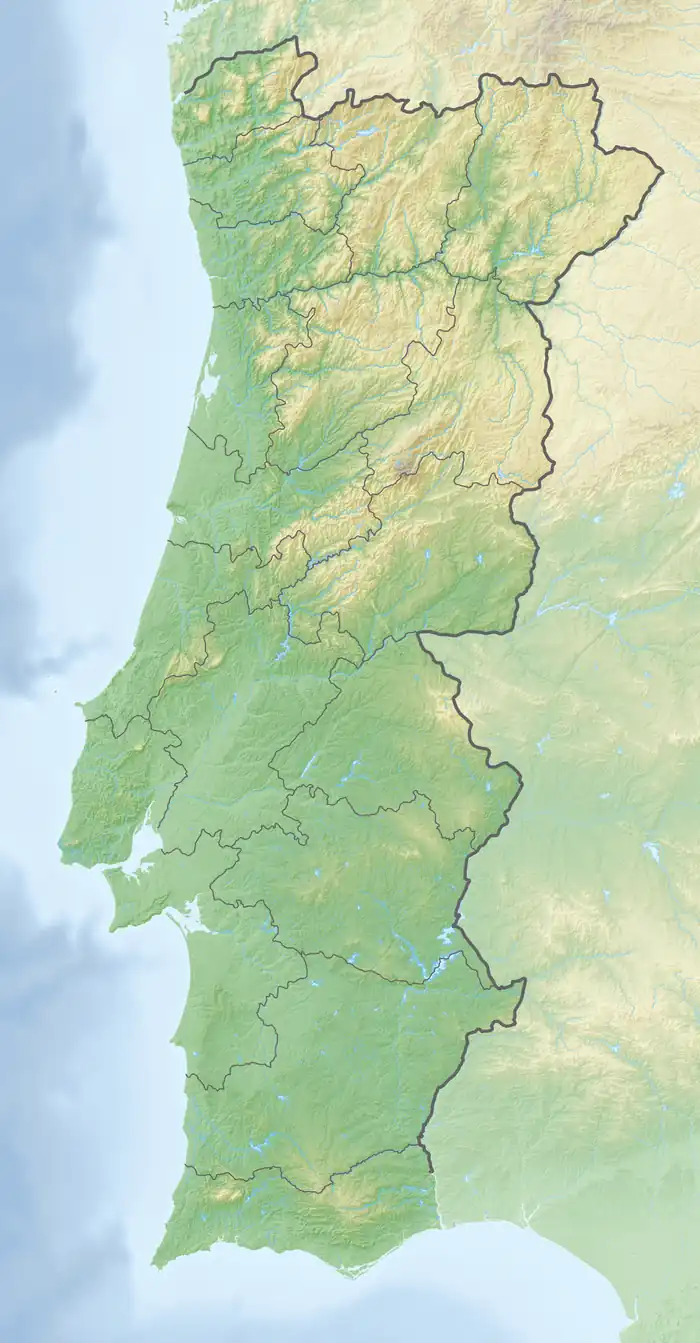Torre (Serra da Estrela)
Torre (English: Tower) is the highest point of mainland Portugal, and the second-highest in the country overall (only Mount Pico, in the Azores, is higher). This point is not a distinctive mountain summit, but rather the highest point in a plateau. Torre has an unusual feature of being a summit that is accessible by paved road, the Regional Road 339 (R 339), formerly National Road 339 (N 339).
| Torre | |
|---|---|
 Trig point that marks the highest point of Continental Portugal. | |
| Highest point | |
| Elevation | 1,993 m (6,539 ft) |
| Prominence | 1,204 m (3,950 ft) |
| Parent peak | Torre Cerredo |
| Listing | Extreme points of Portugal |
| Coordinates | 40°19′18.8″N 07°36′46.6″W |
| Geography | |
 Torre Portugal | |
| Location | Seia, Guarda District, Portugal |
| Parent range | Serra da Estrela (part of Sistema Central) |
| Climbing | |
| First ascent | Unknown |
| Easiest route | Drive |
It is located in a mountain range named Serra da Estrela, on the border between the municipalities of Seia, District of Guarda and Covilhã, District of Castelo Branco.

The actual elevation of this area is 1,993 metres (6,537 feet), according to measures realized by the Instituto Geográfico do Exército (a military organization). Right in the highest point of the mountain range, situated in the middle of a roundabout, near a road that connects the cities of Seia and Covilhã, a trig point that shows the highest point in Serra da Estrela was built.
Near Torre, there are a restaurant, stores with typical products of this region, like the Serra da Estrela cheese, and a ski center called Serra da Estrela Ski Resort, situated in the municipality of Seia. However, the nearest urban area of this place is the city of Covilhã, 20 km (12 mi) away, and the nearest accommodations are situated in the village of Penhas da Saúde, 10 minutes away.
Climate
Torre is the culminating point of the Serra da Estrela range and as such tends to present the lowest temperatures and highest precipitation levels. The climate is defined as a transition between the typical Mediterranean climates seen south of the range and the not-so-typical oceanic climates found north of the range. Precipitation is very high, with around 2,400 mm (94 in), but when compared to lower valley regions of the range, rain is rather weak and continuous.[1] Snow can occur anywhere between October and May, mostly in February, but can be irregular.[2][3]
| Climate data for Torre, 1971-2000 | |||||||||||||
|---|---|---|---|---|---|---|---|---|---|---|---|---|---|
| Month | Jan | Feb | Mar | Apr | May | Jun | Jul | Aug | Sep | Oct | Nov | Dec | Year |
| Average high °C (°F) | 2.5 (36.5) |
3.0 (37.4) |
4.0 (39.2) |
7.5 (45.5) |
10.5 (50.9) |
13.5 (56.3) |
17.5 (63.5) |
17.5 (63.5) |
14.0 (57.2) |
8.5 (47.3) |
4.5 (40.1) |
3.0 (37.4) |
8.8 (47.9) |
| Daily mean °C (°F) | 0.8 (33.4) |
1.2 (34.2) |
2.3 (36.1) |
4.3 (39.7) |
7.2 (45.0) |
10.5 (50.9) |
14.3 (57.7) |
14.3 (57.7) |
11.7 (53.1) |
6.5 (43.7) |
3.2 (37.8) |
1.5 (34.7) |
6.5 (43.7) |
| Average low °C (°F) | −1.0 (30.2) |
−0.5 (31.1) |
0.5 (32.9) |
1.0 (33.8) |
4.0 (39.2) |
7.5 (45.5) |
11.0 (51.8) |
11.0 (51.8) |
9.5 (49.1) |
4.5 (40.1) |
2.0 (35.6) |
0.0 (32.0) |
4.1 (39.4) |
| Average rainfall mm (inches) | 350 (13.8) |
300 (11.8) |
180 (7.1) |
240 (9.4) |
200 (7.9) |
100 (3.9) |
30 (1.2) |
30 (1.2) |
120 (4.7) |
220 (8.7) |
270 (10.6) |
400 (15.7) |
2,440 (96) |
| Source: IPMA[4] | |||||||||||||
References
- Mora 2006, p. 84
- Mora 2006, p. 80
- Mora, Carla Andreia da Silva (2006). "Climas da Serra da Estrela. Características regionais e particularidades locais dos planaltos e do alto Vale do Zêzere" (PDF) (in Portuguese). Retrieved 15 June 2021.
- "Gráficos Monitorização Diária". IPMA.
Sources
- (in English) Serra da Estrela Forecast, Snow Report and Resort Information
- (in English and Portuguese) Região de Turismo da Serra da Estrela
- (in English and Portuguese) Câmara Municipal da Covilhã (Covilhã City Hall)
